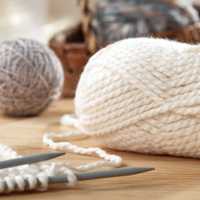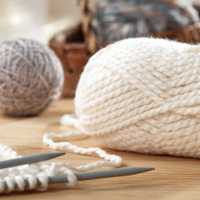Which Craft is Right for Me?
By Emma Snow
Which Craft is Right for Me?
By Emma Snow
Diana discovered the joy of pottery after suffering a terrible divorce. Taking a seat at the wheel with a lump of clay, she felt an immediate release. Her mind cleared and her heart rate slowed down. She was able to relax in a way she hadn’t for weeks. “Better than therapy—and medication!” she happily reported to her doctor after her first day at a community education class, where she went on to make friends with fellow potters, further enriching her life.
For Kris it was counted cross-stitch. The repetitive motion of the needle passing up and down through crisp cloth put her in a near-meditative state, the way yoga does for some. In this state Kris was able to work out solutions to her daily challenges. “It was like the ideas dropped into my mind out of the sky,” she told a close friend.
Shawn found furniture restoration to be wonderfully soothing after a stressful day at the office. The raw scent of wood loosened him up, and he was surprised how satisfying it was to sit down at a table he had restored himself.
Such is the world of DIY. Discovering the right craft for your personality and temperament can be a reward that transforms your life.
The crafting world is as wide and diverse as a tropical rainforest. Each crafting activity has unique benefits and challenges. You could spend your entire life just trying out different crafts. While this may be fun, it can be expensive and frustrating. Should you desire to narrow your search down, this article will act as your guide by investigating the world of crafts as they fit into five spectrums. If one activity doesn’t suit you, take heart. Crafting is for everyone—you are bound to find that perfect match.
- Short-term projects vs. long-term projects.
Do you have a need for immediate gratification? If you do, you might prefer cake decorating, ceramics, candle-making, lotions-n-potions, or cut-n-paste projects (scrapbooking, collage, and decoupage), which deliver results relatively quickly. Conversely, if you are known to possess the patience of Job, needlecrafts and quilting may be your thing. (Although quilting by machine cuts down the time dramatically). If you like long-term projects, pottery and gardening are also excellent choices, since they involve several steps.
- Fastidiousness vs. playfulness/ looseness
Needlecrafts, baking, and jewelry-making require a meticulous and careful eye, whereas cooking, gardening and cut-n-paste projects are more appropriate for the playful type. Keep in mind that many activities can go either way or are best for those who can balance a bit of each quality.
- Planner by nature vs. spontaneous to the core
If you don’t mind doing a little math, counted cross-stitch, knitting, and crochet are great activities. Needlecrafts, quilting and sewing also require planning and pattern-reading. If all this sounds too boring or frustrating and you prefer to jump headlong into projects as soon as you feel an urge, cut-n-paste, candle-making, ceramics, or pottery may be a better fit.
- Space available
Do you affectionately call your apartment a cupboard? If you need an activity that takes up little space or can be cleaned up in a jiffy, yarn and needlecrafts can be tucked away in a basket or a drawer. Baking and cake decorating use what you probably already have in your kitchen, and jewelry only needs a modest tackle-box with little compartments for beads and tools. But perhaps you have a room or a whole basement where a hobby could take up a permanent residence? Pottery is such a hobby. If you quilt by hand you will need a room where a fairly large frame can be set up (unless you only want to do baby quilts). A table for laying out and cutting patterns is required for sewing, and most people don’t appreciate having to lug out the machine every time you want to work on a project. (However, it can be done.) Lotions-n-potions, and candle and soap making can be done in the kitchen as long as precautions are taken, but ideally they need a separate space, since you are using dangerous chemicals that you don’t want to accidentally mix with food. Gardening is ideal if you have a nice-sized yard, but many green-thumbed apartment dwellers find cultivating the space around their windows, on their patio, or even potted indoor plants a satisfying diversion. Don’t lose heart if you don’t have space for an activity that interests you—just sign up for a community class!
- Available funds for expenses
Each craft has a range of what you could pay for the activity, depending on your taste and willingness. If you are picky about using only hand-dyed, organically grown 100% wool yarn, you are going to pay a lot more than someone who works with an acrylic yarn available at the closest Woolworth’s. It is a good idea when just starting out to borrow someone else’s equipment, or use inexpensive supplies until you know it is an activity you are going to stick with. Then you can slowly replace your supplies with quality items that you appreciate. On average, pottery and sewing require more expensive equipment to begin, while you can garden, cross-stitch, or cut-n-paste on a shoestring budget. Yarn crafts are the cheapest activities to try, since they don’t require a lot of expensive equipment to start. Again, a class might be the best investment for the more expensive hobbies.
If you still aren't sure which craft is right for you, talk to other crafters about why they enjoy their craft. Ask if you can join them one day to see if it is something that appeals to you. Be patient with yourself as you begin each new activity--nothing kills the excitement of trying something new more than impossibly high expectations. Don't worry--as you continue, your skills will improve. You will also know better which activities suit you best.
About The Author Emma Snow is a creator at Craft Kits http://www.craft-kits.net leading portals for crafts and creative individuals.
Diana discovered the joy of pottery after suffering a terrible divorce. Taking a seat at the wheel with a lump of clay, she felt an immediate release. Her mind cleared and her heart rate slowed down. She was able to relax in a way she hadn’t for weeks. “Better than therapy—and medication!” she happily reported to her doctor after her first day at a community education class, where she went on to make friends with fellow potters, further enriching her life.
For Kris it was counted cross-stitch. The repetitive motion of the needle passing up and down through crisp cloth put her in a near-meditative state, the way yoga does for some. In this state Kris was able to work out solutions to her daily challenges. “It was like the ideas dropped into my mind out of the sky,” she told a close friend.
Shawn found furniture restoration to be wonderfully soothing after a stressful day at the office. The raw scent of wood loosened him up, and he was surprised how satisfying it was to sit down at a table he had restored himself.
Such is the world of DIY. Discovering the right craft for your personality and temperament can be a reward that transforms your life.
The crafting world is as wide and diverse as a tropical rainforest. Each crafting activity has unique benefits and challenges. You could spend your entire life just trying out different crafts. While this may be fun, it can be expensive and frustrating. Should you desire to narrow your search down, this article will act as your guide by investigating the world of crafts as they fit into five spectrums. If one activity doesn’t suit you, take heart. Crafting is for everyone—you are bound to find that perfect match.
- Short-term projects vs. long-term projects.
Do you have a need for immediate gratification? If you do, you might prefer cake decorating, ceramics, candle-making, lotions-n-potions, or cut-n-paste projects (scrapbooking, collage, and decoupage), which deliver results relatively quickly. Conversely, if you are known to possess the patience of Job, needlecrafts and quilting may be your thing. (Although quilting by machine cuts down the time dramatically). If you like long-term projects, pottery and gardening are also excellent choices, since they involve several steps.
- Fastidiousness vs. playfulness/ looseness
Needlecrafts, baking, and jewelry-making require a meticulous and careful eye, whereas cooking, gardening and cut-n-paste projects are more appropriate for the playful type. Keep in mind that many activities can go either way or are best for those who can balance a bit of each quality.
- Planner by nature vs. spontaneous to the core
If you don’t mind doing a little math, counted cross-stitch, knitting, and crochet are great activities. Needlecrafts, quilting and sewing also require planning and pattern-reading. If all this sounds too boring or frustrating and you prefer to jump headlong into projects as soon as you feel an urge, cut-n-paste, candle-making, ceramics, or pottery may be a better fit.
- Space available
Do you affectionately call your apartment a cupboard? If you need an activity that takes up little space or can be cleaned up in a jiffy, yarn and needlecrafts can be tucked away in a basket or a drawer. Baking and cake decorating use what you probably already have in your kitchen, and jewelry only needs a modest tackle-box with little compartments for beads and tools. But perhaps you have a room or a whole basement where a hobby could take up a permanent residence? Pottery is such a hobby. If you quilt by hand you will need a room where a fairly large frame can be set up (unless you only want to do baby quilts). A table for laying out and cutting patterns is required for sewing, and most people don’t appreciate having to lug out the machine every time you want to work on a project. (However, it can be done.) Lotions-n-potions, and candle and soap making can be done in the kitchen as long as precautions are taken, but ideally they need a separate space, since you are using dangerous chemicals that you don’t want to accidentally mix with food. Gardening is ideal if you have a nice-sized yard, but many green-thumbed apartment dwellers find cultivating the space around their windows, on their patio, or even potted indoor plants a satisfying diversion. Don’t lose heart if you don’t have space for an activity that interests you—just sign up for a community class!
- Available funds for expenses
Each craft has a range of what you could pay for the activity, depending on your taste and willingness. If you are picky about using only hand-dyed, organically grown 100% wool yarn, you are going to pay a lot more than someone who works with an acrylic yarn available at the closest Woolworth’s. It is a good idea when just starting out to borrow someone else’s equipment, or use inexpensive supplies until you know it is an activity you are going to stick with. Then you can slowly replace your supplies with quality items that you appreciate. On average, pottery and sewing require more expensive equipment to begin, while you can garden, cross-stitch, or cut-n-paste on a shoestring budget. Yarn crafts are the cheapest activities to try, since they don’t require a lot of expensive equipment to start. Again, a class might be the best investment for the more expensive hobbies.
If you still aren't sure which craft is right for you, talk to other crafters about why they enjoy their craft. Ask if you can join them one day to see if it is something that appeals to you. Be patient with yourself as you begin each new activity--nothing kills the excitement of trying something new more than impossibly high expectations. Don't worry--as you continue, your skills will improve. You will also know better which activities suit you best.
About The Author Emma Snow is a creator at Craft Kits http://www.craft-kits.net leading portals for crafts and creative individuals.



